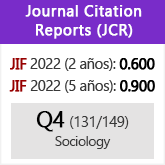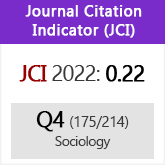Racionalidad limitada
DOI:
https://doi.org/10.3989/ris.2011.10.20Palabras clave:
Complejidad, Juegos secuenciales, Racionalidad limitada, Schelling, SegregaciónResumen
La observación del comportamiento de los agentes económicos tanto en el laboratorio como en la vida real justifica que la racionalidad acotada sea un supuesto aceptado en numerosos modelos socio-económicos. El objetivo de este artículo es ilustrar las dificultades que conlleva una correcta definición de qué es un agente racional (irracional). En este artículo se describen dos marcos que emplean diferentes metodologías para analizar la racionalidad acotada. El primero es un modelo de segregación espacial donde se contrastan dos metodologías de optimización: inducción hacia atrás y hacia adelante. El resultado principal es que, incluso con el mismo nivel de conocimiento, tanto agentes racionales como irracionales podrían coincidir en sus acciones. El segundo marco trabaja sobre la relación entre irracionalidad y restricción de información. Se utiliza el juego llamado “beauty contest” (Nagel 1995) como mecanismo para explicar dicha relación.
Descargas
Citas
Ballester, C. 2004. “NP-completeness in hedonic games.” Games and Economic Behavior 49:1-30. http://dx.doi.org/10.1016/j.geb.2003.10.003
Ballester, C., G. Ponti and M. Van der Leij 2010. “Bounded rationality versus incomplete information in network games.” Mimeo.
Ballester, C., A. Calvó-Armengol and Y. Zenou 2010. “Delinquent Networks.” Journal of the European Economic Association, 8:34-61. http://dx.doi.org/10.1162/jeea.2010.8.1.34
Ballester, C., A. Calvó-Armengol and Y. Zenou. 2006. “Who is Who in Networks. Wanted: The Key Player.” Econometrica 75:1403-1418. http://dx.doi.org/10.1111/j.1468-0262.2006.00709.x
Benito, J., P. Brañas, P. Hernández, and J. Sanchis. 2010. “Strategic behavior in Schelling dynamics: A new result and experimental evidence.” Working Paper 05-2010. ERI-CES. Valencia, Spain.
Benito, J., P. Brañas, P. Hernández and J. Sanchis. 2011. “Sequential vs. Simultaneous Schelling models.” Journal of Conflict and Resolution 55:33-59. http://dx.doi.org/10.1177/0022002710374714
Garey, M. R. and D.S. Johnson 1979. Computers and Intractability. A Guide to the Theory of NP-Completeness. W.H. Freeman.
Govindan, S. and A. J. Robson 1998. “Forward induction, public randomization and admissibility.” Journal of Economic Theory 82:451-457. http://dx.doi.org/10.1006/jeth.1997.2443
Kahneman, D. 2003. “Maps of bounded rationality: psychology for behavioral economics.” The American Economic Review: 93:1449-1475. http://dx.doi.org/10.1257/000282803322655392
Kolmogorov, A. 1998. “On tables of random numbers.” Theoretical Computer Science: 207:387-395. http://dx.doi.org/10.1016/S0304-3975(98)00075-9
Nagel, R. 1995. “Unraveling in guessing games: an experimental study.” American Economic Review: 85:1313-1326.
Neyman, A. 1985. “Bounded complexity justifies cooperation in the finitely repeated prisoner’s dilemma.” Economic Letters 19:227-229. http://dx.doi.org/10.1016/0165-1765(85)90026-6
Neyman, A. 1998. “Finitely repeated games with finite automata.” Mathematics of Operations Research 23:513-552. http://dx.doi.org/10.1287/moor.23.3.513
Gossner, O. P. Hernández and A. Neyman. 2006. “Optimal use of communication resources.” Econometrica 74:1603-1636. http://dx.doi.org/10.1111/j.1468-0262.2006.00720.x
Rubinstein, A. 1986. “Finite automata play the repeated prisoner dilemma.” Journal of Economic Theory 39:83-96. http://dx.doi.org/10.1016/0022-0531(86)90021-9
Rubinstein, A. 1998. Modeling Bounded Rationality. MIT Press.
Schelling, T.C. 1969. “Models of segregation.” American Economic Review, Papers and Proceedings 59:488-493.
Schelling, T.C. 1971. “Dynamic models of segregations.” Journal of Mathematical Sociology 1:143-186. http://dx.doi.org/10.1080/0022250X.1971.9989794
Simon, H. 1955. “A Behavioral Model of Rational Choice.” Quarterly Journal of Economics 69:99-188. http://dx.doi.org/10.2307/1884852
Solomonoff, R.J. 2009. “Algorithmic probability: Theory and applications.” Pp.:1-23 in Information theory and statistical learning. New York: Springer.
Tsang, E.P.K. 2008. “Computational intelligence determines effective rationality.” International Journal on Automation and Control 5:63-66. http://dx.doi.org/10.1007/s11633-008-0063-6
Williamson, O. 1981. “The economies of organization: the transaction cost approach.” American Journal of Sociology 87:548-577. http://dx.doi.org/10.1086/227496
Descargas
Publicado
Cómo citar
Número
Sección
Licencia
Derechos de autor 2012 Consejo Superior de Investigaciones Científicas (CSIC)

Esta obra está bajo una licencia internacional Creative Commons Atribución 4.0.
© CSIC. Los originales publicados en las ediciones impresa y electrónica de esta Revista son propiedad del Consejo Superior de Investigaciones Científicas, siendo necesario citar la procedencia en cualquier reproducción parcial o total.Salvo indicación contraria, todos los contenidos de la edición electrónica se distribuyen bajo una licencia de uso y distribución “Creative Commons Reconocimiento 4.0 Internacional ” (CC BY 4.0). Puede consultar desde aquí la versión informativa y el texto legal de la licencia. Esta circunstancia ha de hacerse constar expresamente de esta forma cuando sea necesario.
No se autoriza el depósito en repositorios, páginas web personales o similares de cualquier otra versión distinta a la publicada por el editor.

















